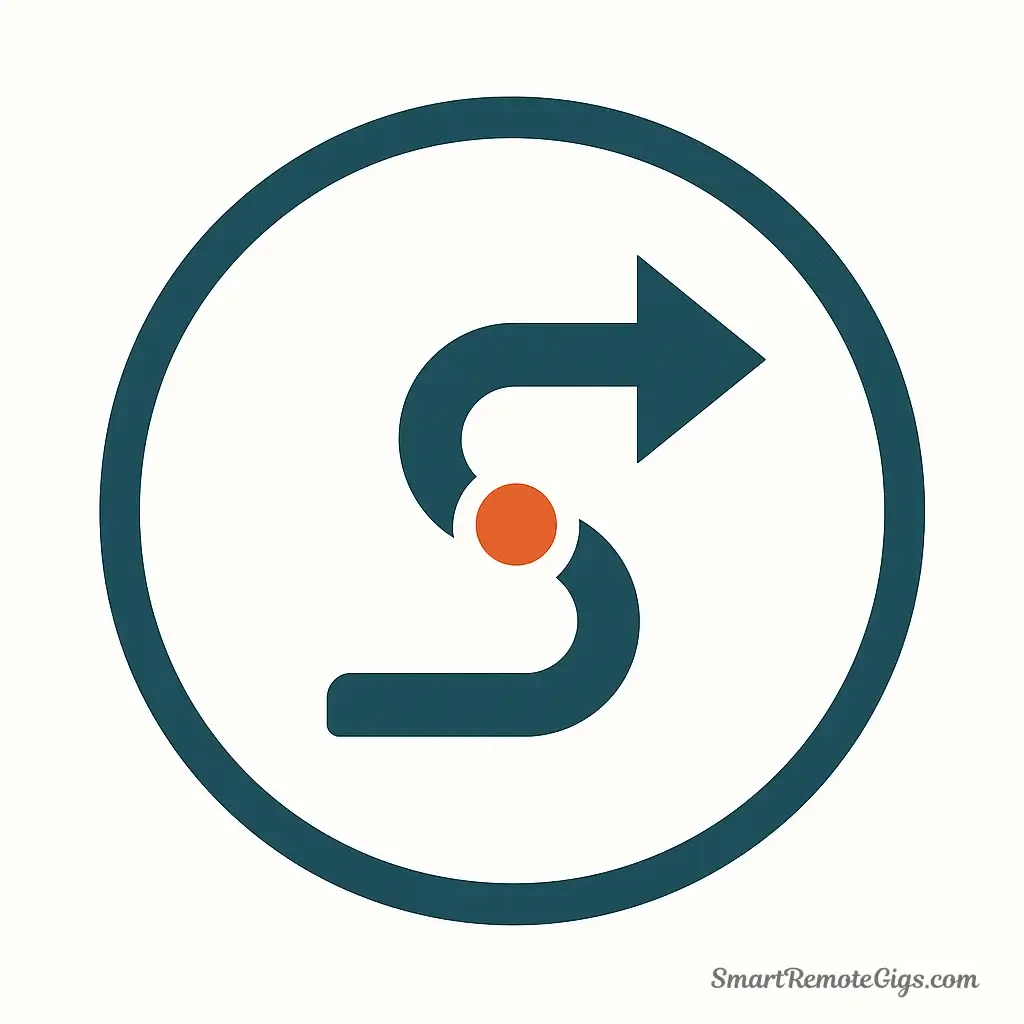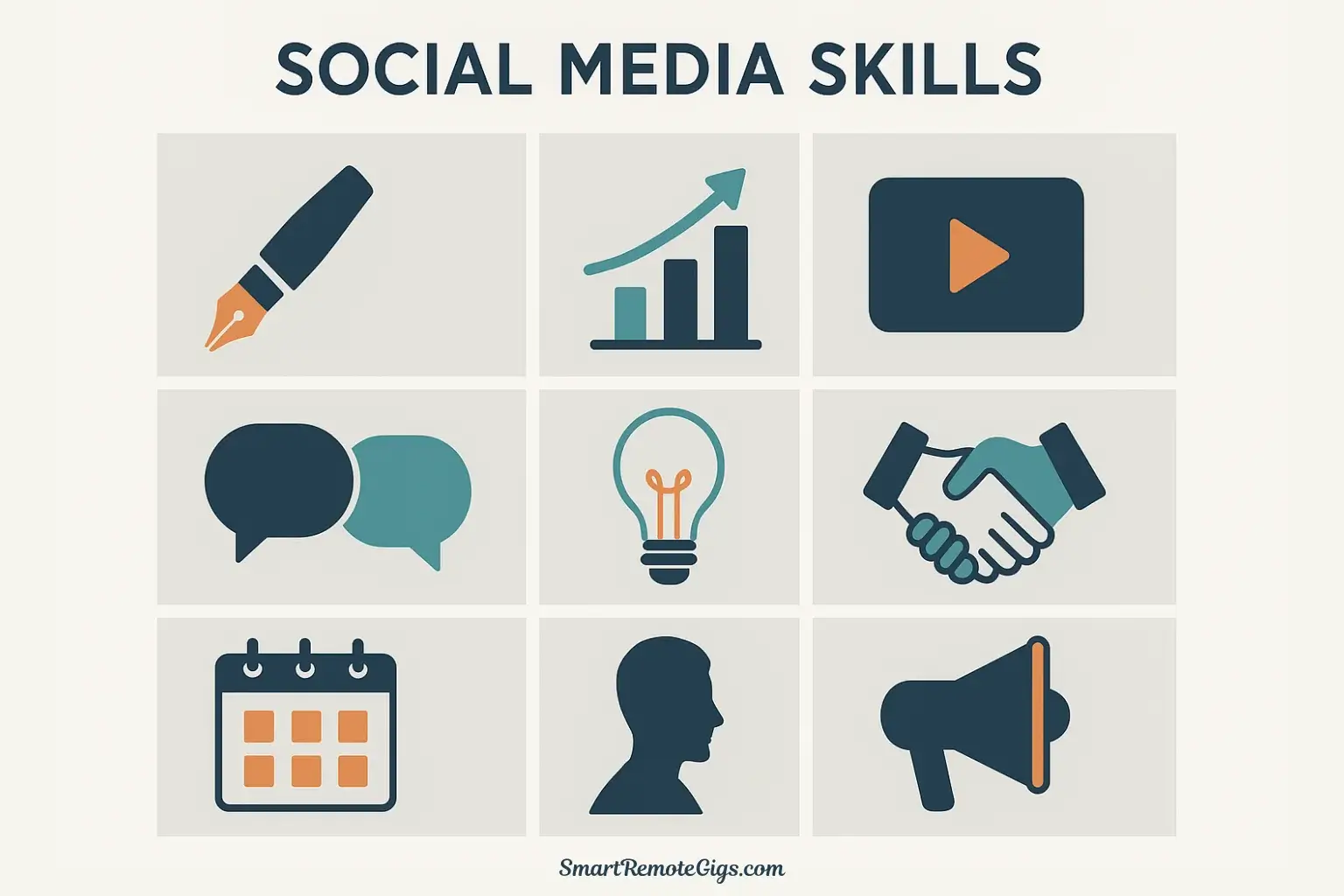It’s not just about posting pretty pictures anymore. Today’s top social media managers are a unique blend of artist, scientist, and strategist—they write compelling copy that stops the scroll, analyze data to prove ROI, manage communities with empathy, and adapt to algorithm changes before most people even notice them.
If you’re trying to break into social media management or advance your career, you’ve probably wondered: what social media manager skills do employers actually care about? Which ones will move the needle in your job search, and which are just nice-to-have extras?
The answer has evolved significantly. Five years ago, being “good at Instagram” might have been enough. Today, hiring managers are looking for professionals who combine creative excellence with business acumen, who can work independently in remote environments, and who understand that social media is a strategic business function—not just a marketing channel.
This guide breaks down the 10 core competencies that will actually get you hired in 2025. We’ve organized them into hard skills (the technical “what you do”) and soft skills (the interpersonal “how you do it”), because mastering both categories is what separates good candidates from great ones.
Whether you’re just starting out or looking to level up, this prioritized list will give you a clear learning path and help you focus your energy on developing the skills needed for social media marketing that employers value most.
The 5 Must-Have Hard Skills (The “What You Do”)
Hard skills are the tangible, teachable abilities you can demonstrate in your portfolio or during a skills assessment. These are the technical competencies that prove you can actually execute the work of social media management.
1. Strategic Copywriting

Social media copywriting is its own unique discipline. It’s not blog writing, it’s not advertising copy, and it’s definitely not academic writing. It’s the art of capturing attention in 3 seconds, communicating value in 280 characters, and compelling action with a single sentence.
What This Skill Includes:
Writing Scroll-Stopping Hooks: The first line of your caption determines whether someone keeps reading or keeps scrolling. Great social media managers know how to open with a question, a surprising statement, or an emotional trigger that demands attention.
Platform-Adapted Voice: A LinkedIn post requires professional authority. A TikTok caption needs casual authenticity. An Instagram caption often blends storytelling with brand personality. The best copywriters seamlessly shift between these voices while maintaining brand consistency.
Strategic Calls-to-Action: Every post should have a purpose. Whether it’s driving comments (“What’s your morning routine?”), generating clicks (“Link in bio to learn more”), or encouraging saves (“Save this for later!”), effective copy guides audience behavior toward business goals.
Hashtag Strategy: Understanding which hashtags expand reach versus which create community, how many to use per platform, and when trending hashtags are worth leveraging requires both research and experimentation.
Accessibility Considerations: Writing alt text for images, using captions on videos, and ensuring copy is inclusive and readable demonstrates both skill and social responsibility.
How to Develop This Skill:
- Study & Analyze: Screenshot high-performing posts in your niche and break down why their copy is effective
- Practice & Test: Write multiple versions of the same caption. If you have an account, A/B test them
- Read the Experts: Dive into books like “Everybody Writes” by Ann Handley or take courses on platforms like Copyblogger
- Write Daily: Consistency is key. The more you write, the better you get. Copywriting improves with volume and repetition
2. Data Analysis & Reporting

The days of “social media is just for brand awareness” are over. Modern social media managers must prove ROI, connect their work to business outcomes, and make data-driven decisions about strategy.
What This Skill Includes:
Understanding Key Metrics: You need to know the difference between reach and impressions, why engagement rate matters more than follower count, what click-through rate reveals about content effectiveness, and how to calculate meaningful conversion metrics. Vanity metrics don’t impress hiring managers—understanding business impact does.
Platform Analytics Interpretation: Each platform offers native analytics (Instagram Insights, TikTok Analytics, LinkedIn Analytics, etc.). You need to know where to find the data that matters, how to identify trends over time, and what performance benchmarks look like for your industry.
Creating Performance Reports: Raw data is meaningless without context and interpretation. Social media managers create weekly snapshots, monthly comprehensive reports, and quarterly strategic reviews that translate numbers into narratives that stakeholders can understand and act on.
A/B Testing & Optimization: The best social media managers constantly experiment—testing posting times, content formats, caption styles, and visual approaches—then use data to systematically improve performance.
Attribution & ROI Calculation: Increasingly, you need to connect social media efforts to revenue using UTM parameters, conversion tracking, and attribution models. Understanding tools like Google Analytics (including GA4) is becoming essential.
How to Develop This Skill:
- Take Free Courses: Complete the Google Analytics Academy courses to build foundational data literacy
- Practice Reporting: If you manage any social accounts (even personal ones), start creating monthly reports for yourself to practice data interpretation
- Learn Spreadsheet Basics: Master Excel or Google Sheets fundamentals—pivot tables and data visualization will become invaluable
- Follow Data Experts: Follow social media analytics professionals on LinkedIn and learn how they present data effectively
3. Content Creation & Basic Design

You don’t need to be a professional graphic designer or videographer, but you do need to create visually appealing content that aligns with brand standards and performs well on each platform.
What This Skill Includes:
Graphic Design Fundamentals: Understanding color theory, typography, visual hierarchy, and composition principles helps you create graphics that are both aesthetically pleasing and strategically effective. Tools like Canva have made design accessible, but you still need to understand what makes design work.
Template Creation & Brand Consistency: Creating reusable templates for common content types (quote graphics, educational carousels, announcement posts) ensures visual consistency while saving time. You need to understand how to establish and maintain a cohesive visual identity across platforms.
Basic Video Editing: Short-form video dominates social media in 2025. You need comfort with mobile editing apps like CapCut, InShot, or Adobe Premiere Rush—adding captions, cutting clips, incorporating trending audio, applying transitions, and optimizing for platform specifications.
Photo Editing & Enhancement: Basic photo editing in apps like Lightroom Mobile, VSCO, or Snapseed—adjusting brightness, contrast, saturation, and applying consistent filters—keeps your feed looking professional.
Content Adaptation: Understanding how to resize and reformat content for different platforms (Instagram’s square vs. TikTok’s vertical vs. LinkedIn’s horizontal) and knowing each platform’s technical requirements (file sizes, aspect ratios, length limits) is essential.
How to Develop This Skill:
- Learn by Recreating: Start by recreating designs you admire to understand how they work
- Take Platform Courses: Complete Canva’s free design courses to learn fundamentals
- Practice Video Daily: Shoot and edit short videos on your phone—the best way to learn is by doing
- Study Visual Identities: Analyze accounts with strong visual brands and identify what makes them cohesive
- Follow Design Trends: Follow designers on social media to stay current with evolving trends
4. Community Management

This is the human side of social media—the relationship building, conflict resolution, and authentic engagement that turns followers into community members and customers into advocates.
What This Skill Includes:
Authentic Engagement: Moving beyond generic “Thanks for sharing!” responses to create meaningful interactions that make followers feel seen, heard, and valued. This includes asking thoughtful follow-up questions, referencing previous conversations, and showing genuine interest in your community.
Brand Voice Consistency: Whether you’re responding to a positive comment or addressing a complaint, maintaining the brand’s established voice and tone across all interactions ensures a cohesive experience. You need to know when to be playful, when to be professional, and when to be empathetic.
Conflict De-escalation: Handling negative comments, complaints, or PR crises with grace and strategy is critical. You need to know when to respond publicly versus privately, how to show empathy without admitting fault, when to bring in leadership or legal, and how to turn a detractor into a defender through excellent service.
Proactive Community Building: The best community managers don’t just respond—they initiate. This means highlighting user-generated content, celebrating community milestones, creating conversation starters, facilitating connections between community members, and making followers feel like part of something bigger than just a customer base.
Social Listening: Monitoring mentions of your brand (even when not tagged), tracking competitor activity, identifying emerging trends in your industry, and understanding audience sentiment requires active listening across platforms and sometimes specialized tools.
How to Develop This Skill:
- Get Hands-On Practice: Manage your own social accounts or volunteer to handle social for a nonprofit organization
- Study Brand Responses: Analyze how brands you admire handle negative comments and customer service issues
- Take Customer Service Training: Many community management principles overlap with customer service best practices
- Read Community Building Books: Dive into “The Art of Community” by Jono Bacon for deeper understanding
- Lead with Empathy: Genuinely care about people—empathy can’t be faked, and audiences can always tell
5. Platform-Specific Expertise

Being a “generalist” who knows a little about every platform isn’t enough anymore. Employers want specialists who deeply understand the platforms most relevant to their audience.
What This Skill Includes:
Algorithm Understanding: Each platform’s algorithm works differently. Instagram rewards saves and shares. TikTok prioritizes watch time and completion rate. LinkedIn favors comments and meaningful engagement. Understanding these mechanics helps you optimize content for maximum visibility.
Platform-Native Features: Knowing when to use Instagram Stories vs. Reels vs. carousel posts, understanding LinkedIn articles vs. posts vs. newsletters, or leveraging TikTok stitches and duets effectively demonstrates true platform expertise.
Audience Behavior by Platform: The same audience behaves differently on different platforms. Your LinkedIn followers expect thought leadership and professional insights. Your TikTok audience wants entertainment and authenticity. Your Instagram community engages with aesthetic visual storytelling. Understanding these nuances shapes your content strategy.
Emerging Features & Beta Access: Platform experts stay ahead of the curve, testing new features early (often getting beta access), understanding how to leverage new tools for competitive advantage, and adapting strategy as platforms evolve.
Best Practices & Optimization: From optimal posting times to ideal video lengths to effective hashtag strategies, each platform has unique best practices that evolve constantly. True expertise means staying current through continuous learning.
How to Develop This Skill:
- Focus Your Learning: Choose 2-3 platforms most relevant to your target industry and become an expert in them
- Follow Platform Educators: Follow platform-specific creators who teach strategy (not just personal branding)
- Read Official Resources: Study platform blogs, creator resources, and official documentation
- Experiment Constantly: Test new features and strategies with your own accounts
- Join Professional Communities: Participate in platform-specific groups where professionals share insights and strategies
The 5 Crucial Soft Skills (The “How You Do It”)
Soft skills are the interpersonal and self-management abilities that determine how effectively you work, especially in remote environments. These skills often matter more than technical abilities when it comes to long-term success and career advancement.
6. Adaptability

Social media changes faster than almost any other profession. Algorithms update overnight. Platforms rise and fall. Trends emerge and disappear in days. The most successful social media managers thrive in this uncertainty rather than being paralyzed by it.
Why This Skill Matters:
A strategy that worked last quarter might be ineffective today. A platform that drove 80% of your traffic might suddenly change its algorithm. A content format that was trending might become oversaturated. Adaptable social media managers pivot quickly, experiment with new approaches without fear of failure, learn from what doesn’t work and adjust rapidly, and stay calm when plans need to change.
How to Develop This Skill:
- Embrace Growth Mindset: View challenges as learning opportunities rather than threats
- Practice Small Experiments: Build comfort with change by regularly testing new approaches
- Stay Informed: Follow industry news so changes don’t surprise you
- Build in Flexibility: Create content calendars with room to pivot when needed
- Reflect on Past Adaptations: Identify what helped you successfully navigate previous changes
7. Proactive Communication

In remote work environments, the responsibility for clear, timely communication falls entirely on you. You can’t rely on casual hallway conversations or quick desk drop-bys. Proactive communication is what keeps remote teams functioning smoothly.
Why This Skill Matters:
Remote social media managers must provide status updates without being asked, flag potential issues before they become crises, ask clarifying questions early rather than making assumptions, document decisions and processes for team reference, and keep stakeholders informed about performance, challenges, and opportunities.
What This Looks Like in Practice:
- Sending a quick Slack message when you’ve completed a milestone
- Bringing up a concern in your 1:1 before it impacts deliverables
- Creating a summary document after meetings so everyone has shared understanding
- Proactively sharing a competitor’s campaign you noticed rather than waiting for someone to ask
- Updating your manager on campaign performance without waiting for the weekly report
How to Develop This Skill:
- Overcommunicate Initially: You can always scale back if needed, but start by sharing more than feels necessary
- Use Project Management Tools: Maintain visibility into your work through Asana, Trello, or similar platforms
- Schedule Regular Check-Ins: Don’t wait for others to initiate—create consistent communication touchpoints
- Practice Concise Writing: Learn to write clear, efficient updates that respect others’ time
- Seek Communication Feedback: Ask for input on your communication style and adjust accordingly
8. Time Management & Organization

Social media managers juggle multiple platforms, competing deadlines, unexpected crises, and both proactive and reactive work. Without excellent organizational systems, things fall through the cracks.
Why This Skill Matters:
You need to maintain consistent posting schedules across platforms, respond to comments and messages within reasonable timeframes, meet deadlines for campaigns and reports, balance planned content with timely, reactive posts, and manage your energy across creative, analytical, and administrative tasks.
What This Looks Like in Practice:
- Using content calendars to plan 2-4 weeks ahead
- Time-blocking your day for different types of work (creative deep work in the morning, meetings midday, analytics in the afternoon)
- Creating SOPs (standard operating procedures) for recurring tasks to improve efficiency
- Using project management tools to track deliverables and dependencies
- Building buffer time into your schedule for unexpected issues
How to Develop This Skill:
- Experiment with Systems: Try different productivity methods (time-blocking, Pomodoro Technique, Getting Things Done) until you find what works
- Externalize Task Management: Use tools like Asana, Trello, or Notion instead of relying on memory
- Batch Similar Tasks: Write all captions at once, schedule all posts at once—batching increases efficiency
- Track Your Time: Monitor how you actually spend time for a week to identify inefficiencies
- Learn to Say No: Negotiate deadlines or decline additional work when your plate is legitimately full
9. Creativity

Social media feeds are saturated. Attention spans are short. Standing out requires genuine creativity—the ability to generate fresh ideas, find unique angles on common topics, and create content that makes people stop scrolling.
Why This Skill Matters:
Creativity is what makes your brand memorable rather than forgettable. It’s what turns a product announcement into shareable content. It’s what helps you leverage trends in unexpected ways. It’s what keeps your content from feeling stale and repetitive.
What This Looks Like in Practice:
- Finding a unique format for presenting information (like turning tips into a “choose your own adventure” carousel)
- Adapting a trending audio in an unexpected, brand-relevant way
- Connecting two seemingly unrelated ideas to create surprising content
- Solving the problem of “we don’t have budget for professional photography” with creative smartphone solutions
- Telling your brand story in ways that feel fresh rather than formulaic
How to Develop This Skill:
- Consume Widely: Read outside your industry, follow diverse creators, explore art and culture
- Maintain a Swipe File: Keep a collection of content that inspires you and review it regularly
- Practice Brainstorming: Generate ideas without judgment—quantity leads to quality
- Collaborate with Others: Creativity often emerges in conversation with different perspectives
- Embrace Bad Ideas: Give yourself permission to create imperfect first drafts; you can refine them later
- Take Strategic Breaks: Creativity thrives when your mind has space to wander
10. Audience Empathy

The best social media managers don’t just understand their audience demographically—they understand them emotionally. They know what keeps their audience up at night, what makes them laugh, what problems they’re trying to solve, and what makes them feel seen and understood.
Why This Skill Matters:
Empathy informs everything—the language you use, the problems you address, the tone you strike, the content you create. It’s what makes engagement feel authentic rather than transactional. It’s what helps you anticipate what your audience needs before they ask for it.
What This Looks Like in Practice:
- Choosing topics based on audience pain points rather than what the company wants to promote
- Writing in language your audience actually uses rather than corporate jargon
- Responding to comments in ways that show you truly heard the person
- Creating content that serves your audience’s needs rather than just pushing products
- Advocating internally for decisions that benefit your community even when they’re not immediately profitable
How to Develop This Skill:
- Immerse Yourself: Spend genuine time in your audience’s world—read their Reddit threads, listen to their podcasts, understand their challenges
- Conduct Research: Use surveys and interviews to go beyond assumptions
- Listen Actively: Read comments and DMs not just to respond but to truly understand
- Practice Perspective-Taking: Regularly imagine yourself as your target audience member and ask what would actually be valuable
- Study Human Behavior: Learn about psychology and what drives decision-making and engagement
How to Showcase These Skills
Knowing these remote social media manager qualifications is one thing. Proving you have them is what actually gets you hired.
Employers don’t just want to read “I’m great at data analysis” on your resume—they want to see a case study showing how you used analytics to improve engagement by 40%. They don’t want to hear “I’m creative”—they want to see a portfolio of content that demonstrates your creativity in action.
The gap between knowing what skills matter and being able to demonstrate them is where most candidates get stuck. That’s why the next critical step in your journey is building a portfolio that showcases these competencies through real, tangible projects.
Whether you’re completely new to social media management or you’re trying to transition from a related field, you need proof of your abilities. The good news? You can create this proof yourself, even without formal work experience.
Ready to put these skills into practice? Read our guide: 5 Projects to Build Your SMM Portfolio From Scratch to learn how to create portfolio pieces that demonstrate every skill on this list—and get you noticed by hiring managers.
Putting It All Together: Your Complete Career Roadmap
Mastering these 10 skills is the foundation of your career. Building a portfolio, as outlined in our project guide, is the critical next step to prove your abilities.
But how do you tie it all together? How do you use these skills and your new portfolio to find the right jobs, write a killer remote-ready resume, nail the video interviews, and negotiate a salary that reflects your value?
That’s where our complete pillar guide comes in. It’s the strategic roadmap that shows you how to put all the pieces together, taking you from learning the skills to landing your dream remote social media manager job.
➡️ The Big Picture: How to Become a Remote Social Media Manager (The Complete 2025 Guide)
Top 10 Essential Social Media Manager Skills
Strategic Copywriting
The ability to write compelling, platform-adapted copy that grabs attention, drives engagement, and includes strategic calls-to-action.
A non-negotiable skill. Excellent copywriting is the foundation of all engaging social media content and directly impacts performance.
Editor’s Rating:
Price: Free
Visit WebsiteData Analysis & Reporting
The skill of interpreting social media metrics, creating performance reports, and using data to make strategic, ROI-driven decisions.
Arguably the most in-demand skill. The ability to prove ROI separates top-tier professionals from entry-level candidates.
Editor’s Rating:
Price: Free
Visit WebsiteContent Creation & Basic Design
Proficiency in creating visually appealing graphics and editing short-form video content that aligns with brand standards and platform best practices.
Essential for the modern SMM. While you don't need to be a designer, basic proficiency in tools like Canva and CapCut is now expected.
Editor’s Rating:
Price: Free
Visit WebsiteCommunity Management
The ability to build relationships, handle negative feedback, and foster authentic engagement to turn followers into a loyal community.
The human side of social media. Great community management builds brand loyalty and provides invaluable customer insights.
Editor’s Rating:
Price: Free
Visit WebsitePlatform-Specific Expertise
Deep understanding of how different social media algorithms work, including their native features and audience behaviors, to optimize content for maximum reach.
Employers want specialists, not just generalists. Deep expertise in 2-3 key platforms relevant to the industry is a major differentiator.
Editor’s Rating:
Price: Free
Visit WebsiteAdaptability
The ability to pivot strategies quickly in response to algorithm changes, emerging trends, and evolving platform landscapes.
The most crucial soft skill in an industry that changes constantly. Those who embrace change thrive; those who resist it fall behind.
Editor’s Rating:
Price: Free
Visit WebsiteProactive Communication
A crucial remote work skill involving clear, timely updates and documentation to keep teams aligned across different time zones.
In remote work, proactive communication is the bedrock of trust and efficiency. Managers value team members who keep them informed without being asked.
Editor’s Rating:
Price: Free
Visit WebsiteTime Management & Organization
The skill of juggling multiple platforms, deadlines, and content calendars effectively through systems like time-blocking and task batching.
Social media is a constant balancing act. Strong organizational systems are what prevent burnout and ensure consistent, high-quality output.
Editor’s Rating:
Price: Free
Visit WebsiteCreativity
The ability to generate fresh ideas and find unique angles to create content that stands out in a saturated social media feed.
Creativity is what makes a brand memorable. It's the skill that helps you leverage trends in unique ways and keeps your content from feeling generic.
Editor’s Rating:
Price: Free
Visit WebsiteAudience Empathy
The emotional intelligence to deeply understand an audience's needs, pain points, and motivations to create content that truly resonates.
Empathy is the secret ingredient behind all great social media. Understanding your audience on a human level informs every strategic and creative decision.
Editor’s Rating:
Price: Free
Visit Website





